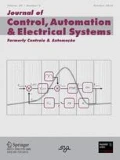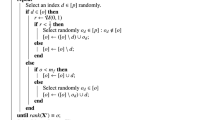Abstract
This paper addresses the problem of structure detection for polynomial NARX models. It develops MERR, a multiobjective extension of a methodology well-known as the error reduction ratio (ERR). It is shown that it is possible to choose terms which take into account dynamics of prediction error and other types of affine information, such as fixed points or static curve. Two examples are included to illustrate the proposed methodology. A numerical example shows that the technique is able to reconstruct the structure of a system, known a priori. The identification of a pilot DC–DC buck converter shows that the proposed approach is capable to find models valid over a wide range of operation points. In this latter example, MERR is compared with ERR in two forms: (i) affine information is applied only in the structure selection for MERR and (ii) affine information is applied for structure selection for MERR and for parameter estimation for both MERR and ERR. In both comparisons, MERR presented nondominated solutions of Pareto set.


Similar content being viewed by others
Notes
Notice that this is not true if any functional \(J_j\) is not convex.
References
Aguirre, L. A., & Billings, S. A. (1994). Model reference control of regular and chaotic dynamics in the Duffing-Ueda oscillator. IEEE Transactions on Circuits and Systems, Part I, 41(7), 477–480.
Aguirre, L. A., & Billings, S. A. (1995). Improved structure selection for nonlinear models based on term clustering. International Journal of Control, 62(3), 569–587.
Aguirre, L. A., Donoso-Garcia, P. F., & Santos, R. (2000). Use of a priori information in the identification of global nonlinear models—A case study using a buck converter. IEEE Transactions on Circuits and Systems I: Fundamental Theory and Applications, 47(7), 1081–1085.
Aguirre, L. A., Freitas, U. S., Letellier, C. S., & Maquet, J. (2001). Structure-selection techniques applied to continuous-time nonlinear models. Physica D 158(1–4), 1–18. doi:10.1016/S0167-2789(01)00313-X.
Akaike, H.: New look at statistical-model identification. IEEE Transactions on Automatic Control 19(6), 716–723 (1974). doi:10.1109/TAC.1974.1100705.
Baldacchino, T., Anderson, S. R., & Kadirkamanathan, V. (2012). Structure detection and parameter estimation for NARX models in a unified EM framework. Automatica, 48(5), 857–865.
Barroso, M. F. S., Takahashi, R., & Aguirre, L. (2007). Multi-objective parameter estimation via minimal correlation criterion. Journal of Process Control, 17(4), 321–332.
Bonin, M., Seghezza, V., & Piroddi, L. (2010). NARX model selection based on simulation error minimisation and LASSO. IET Control Theory and Applications 4(7), 1157–1168. doi:10.1049/iet-cta.2009.0217.
Cantelmo, C., & Piroddi, L. (2010). Adaptive model selection for polynomial NARX models. IET Control Theory and Applications, 4(12), 2693–2706.
Chankong, V., & Haimes, Y. Y. (1983). Multiobjective decision making: Theory and methodology. New York: North-Holland (Elsevier).
Chen, S., & Billings, S. A. (1989). Representations of non-linear systems: The NARMAX model. International Journal of Control, 49(3), 1013–1032.
Johansen, T. A. (1996). Identification of non-linear systems using empirical data and prior knowledge—An optimization approach. Automatica, 32(3), 337–356.
Korenberg, M., Billings, S., Liu, Y., & Mcilroy, P. (1988). Orthogonal parameter estimation algorithm for non-linear stochastic systems. International Journal of Control, 48(1), 193–210.
Leontaritis, I. J., & Billings, S. A. (1985). Input–output parametric models for non-linear systems—Part I: Deterministic non-linear systems. International Journal of Control, 41(2), 303–328.
Ljung, L. (1987). System identification: Theory for the user. London: Prentice-Hall.
Mendes, E. M. A. M., & Billings, S. A. (2001). An alternative solution to the model structure selection problem. IEEE Transactions on Systems Man and Cybernetics: Part A—Systems and Humans, 31(6), 597–608. doi:10.1109/3468.983416.
Nepomuceno, E. G., Takahashi, R. H. C., & Aguirre, L. A. (2007). Multiobjective parameter estimation for non-linear systems: Affine information and least-squares formulation. International Journal of Control, 80(6), 863–871.
Piroddi, L., & Spinelli, W. (2003). An identification algorithm for polynomial NARX models based on simulation error minimization. International Journal of Control, 76(17), 1767–1781.
Previdi, F., & Lovera, M. (2004). Identification of non-linear parametrically varying models using separable least squares. International Journal of Control, 77(16), 1382–1392.
Wei, H. L., & Billings, S. A. (2008). Model structure selection using an integrated forward orthogonal search algorithm assisted by squared correlation and mutual information. International Journal of Modelling Identification and Control, 3(4), 341–356.
Wei, H. L., & Billings, S. A. (2009). Improved parameter estimates for non-linear dynamical models using a bootstrap method. International Journal of Control, 82(11), 1991–2001.
Zhao, W. X., Chen, H. F., & Zhou, T. (2011). New results on recursive identification of NARX systems. International Journal of Adaptative Control and Signal Processing, 25(10), 855–875.
Acknowledgments
The authors are thankful to FAPEMIG, INERGE, CAPES, and CNPq.
Author information
Authors and Affiliations
Corresponding author
Rights and permissions
About this article
Cite this article
Martins, S.A.M., Nepomuceno, E.G. & Barroso, M.F.S. Improved Structure Detection For Polynomial NARX Models Using a Multiobjective Error Reduction Ratio. J Control Autom Electr Syst 24, 764–772 (2013). https://doi.org/10.1007/s40313-013-0071-9
Received:
Revised:
Accepted:
Published:
Issue Date:
DOI: https://doi.org/10.1007/s40313-013-0071-9




